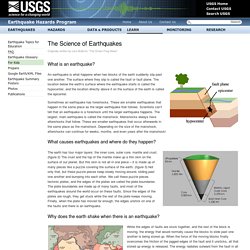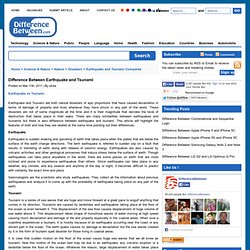

EQ. Global plate tectonic movement Earthquakes are measured using observations from seismometers.

The moment magnitude is the most common scale on which earthquakes larger than approximately 5 are reported for the entire globe. The more numerous earthquakes smaller than magnitude 5 reported by national seismological observatories are measured mostly on the local magnitude scale, also referred to as the Richter scale. These two scales are numerically similar over their range of validity. Magnitude 3 or lower earthquakes are mostly almost imperceptible or weak and magnitude 7 and over potentially cause serious damage over larger areas, depending on their depth. Science of EQs. What is an earthquake?

An earthquake is what happens when two blocks of the earth suddenly slip past one another. The surface where they slip is called the fault or fault plane. The location below the earth’s surface where the earthquake starts is called the hypocenter, and the location directly above it on the surface of the earth is called the epicenter. Sometimes an earthquake has foreshocks. EQ Anatomy. Richter scale. The Richter magnitude scale (often shortened to Richter scale) was developed to assign a single number to quantify the energy that is released during an earthquake.

The scale is a base-10 logarithmic scale. The magnitude is defined as the logarithm of the ratio of the amplitude of waves measured by a seismograph to an arbitrary small amplitude. An earthquake that measures 5.0 on the Richter scale has a shaking amplitude 10 times larger than one that measures 4.0, and corresponds to a 31.6 times larger release of energy.[1] Since the mid-20th century, the use of the Richter magnitude scale has largely been supplanted by the moment magnitude scale (MMS) in many countries. However, the Richter scale is still widely used in Russia and other CIS countries. Development[edit] Charles Richter, c. 1970 (local magnitude) was not designed to be applied to data with distances to the hypocenter of the earthquake greater than 600 km[3] (373 mi) . . , and a body wave magnitude scale scale. Scale. Scale. Lists of earthquakes. The following is a list of earthquake lists, and of top earthquakes by magnitude and fatalities.

Main lists[edit] Lists of earthquakes by country[edit] Largest earthquakes by magnitude[edit] A pie chart comparing the seismic moment release of the three largest earthquakes for the hundred year period from 1906 to 2005 with that for all earthquakes of magnitudes <6, 6 to 7, 7 to 8 and >8 for the same period Earthquakes of magnitude 8.0 and greater since 1900. Listed below are all known earthquakes measured or estimated to have a moment magnitude scale or Richter magnitude scale of 8.5 and above. This list is biased towards recent years due to development and widespread deployment of seismometers. Deadliest earthquakes on record[edit] Property damages caused by earthquake[edit] See also[edit] References[edit] Jump up ^ USGS: Magnitude 8 and Greater Earthquakes Since 1900Jump up ^ Weeks, Linton (March 13, 2011).
External links[edit] Earthquake Magnitude vs Intensity. Why we can't predict the next big EQ. How do you build for an EQ? How EQ prediction works. Japanese video shows the warning leading up to the quake.

By Alan Boyle, Science Editor, NBC News Japan has spent well more than $1 billion on earthquake prediction systems, including a network of more than 1,000 GPS-based sensors scattered around the country — and the payoff came today when Tokyo's residents were given up to a minute's warning that a Big One was on the way. That may not sound like much, but it's enough time for people to switch off their gas lines and get beneath a table or a door frame. "The system functioned well, because warnings were seen on television across the country," Hirohito Naito, a seismic expert at the Japan Meterological Agency, told AFP.
The agency is in charge of quake preparedness as well as weather forecasting, and researchers have invested decades of effort into Japan's early-warning system. The early warning system isn't that useful for those who are close to the epicenter, because the S-waves come quickly behind the P-waves. Earthquake vs Tsunami. Earthquake vs Tsunami Earthquake and Tsunami are both natural disasters of epic proportions that have caused devastation in terms of damage of property and lives whenever they have struck in any part of the world.

These disasters are not of same magnitude all the time and it is their magnitude that decides the level of destruction that takes place in their wake. There are many similarities between earthquakes and tsunamis but there is also difference between earthquake and tsunami. This article will highlight the features of both and how they are related at the same time pointing out their differences.